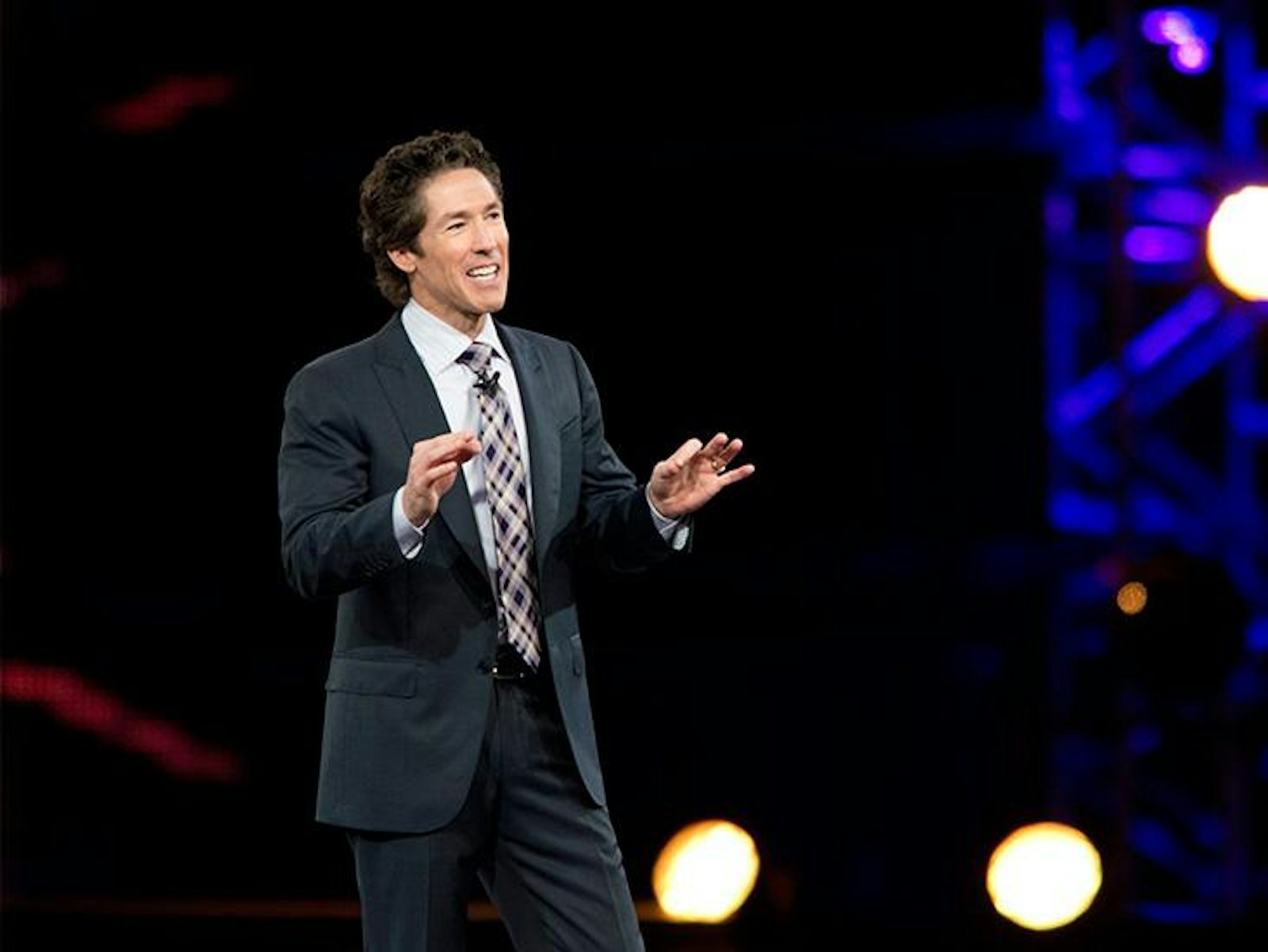It’s hard to quantify charisma, but by any measure Joel Osteen has some pretty impressive stats. Every week, the man some call “The Smiling Preacher,” draws an estimated 43,500 individuals to his Lakewood Church, which he moved into a former professional basketball stadium just off Houston’s Highway 59 in 2005. Osteen’s weekly sermons are beamed across seven networks in the United States and, by some estimates, reach 95 percent of the nation’s households and more than 150 countries.
The 53-year-old pastor, with his boyish good looks, ubiquitous incisors, and his impeccably coiffed mane of wavy, brown locks, oversees a budget estimated at upward of $70 million. He has penned no less than seven best sellers (most derived from his sermons), has amassed a net worth estimated at $40 million, with book sales and related revenue reportedly exceeding $55 million, and lives in a 17,000-square foot, $10.5 million mansion. All of it is built upon the personality—the words, the wisdom, and in no small part the charisma—of the man the congregants of the nation’s largest charismatic church refer to, simply, as “Pastor Joel.”
So, what is it that makes Osteen different from the rest of us? What is the source of his magical magnetism?
Many—including Osteen himself—might attribute his gifts to the favor of a higher power. After all, charisma, wrote the early 20th century German sociologist Max Weber, who gave the word its most widely used modern definition, is a quality that sets an individual “apart from ordinary men,” and causes others to treat him as “endowed with supernatural, superhuman, or at least specifically exceptional powers or qualities.”
But there’s a small but growing group of individuals who have another explanation. Using brain-scan technologies and modern statistical techniques, a band of committed academics in recent years have set out to decipher that mysterious quality from which legendary leadership is born. And some have reached what a previous generation of observers might have considered a dubious conclusion: That it’s possible not just to reverse-engineer charisma, but that it’s something, at least in part, we might learn to master.
“Charismatic tactics can be taught, and the more charismatic leadership tactics used, the more individuals will be seen as leader-like by others,” says John Antonakis, a professor of Organizational Behavior, and Director of the Ph.D. program in management at the University of Lausanne. (Read the Nautilus feature about how we create charismatic leaders and the dangerous consequences of their power.)
Right out of the gate, Osteen is using three of Antonakis’ identified tactics.
By studying well-known charismatics and replicating their actions in the lab, Antonakis has identified a series of what he calls Charismatic Leadership Tactics (CLTs), which range from the use of metaphors and storytelling, to nonverbal methods of communication like open posture and animated gestures at key moments.
At the request of Nautilus, Antonakis assigned a doctoral student, Benjamin Tur, to sit down and code the first 10 minutes of a 2012 sermon by Osteen, “The Power of I Am,” a speech that Oprah Winfrey says changed her life.
The sermon opens with a photographic montage that includes an image of a smiling Osteen, standing with his photogenic family—son, daughter, and wife—autumn leaves cascading joyfully down around them. It moves to snapshots of his son throwing a football, his daughter kissing a puppy dog, and finally lands on Joel standing with his beautiful wife Victoria, her long blonde hair billowing gently in the wind. The screen cuts to a camera slowly moving over a huge multiracial stadium crowd of all shapes and sizes, panning in and resting with the handsome Osteen. That’s when the magic begins.
Osteen is clad in an impeccable Cerulean blue suit, crisp white shirt and purple, paisley tie, and he is at that very moment, extending his arm and open hand outward toward the screen—toward me—toward all of us—beckoning viewers to join him.
“God bless you! It’s a joy to come into your homes,” Osteen says, pointing his index finger E.T.-like at the viewing audience for just a second, flashing a humble smile, then leaning his right shoulder ever so slightly toward the camera, while blinking his long eyelashes rapidly, as if awakening to a bright, glorious morning. “We love you. If you are ever in our area, please stop by and be a part of one of our services! I promise you we’ll make you feel right at home. Thanks so much for tuning in.”
Osteen shambles over to a wooden podium, places a hand gently on its edge, and tells the audience he likes to start with “something funny.”
“I heard about this 92-year-old man,” Osteen begins. “He wasn’t feeling up to par and he went to the doctor for a checkup. A few days later the doctor saw him walking in the park. He had this beautiful young lady by his side and he seemed as happy as can be. The doctor said, ‘Wow you sure are feeling a lot better aren’t you!’ He said, ‘Yes, doctor, I’m just taking your orders. You said, ‘Get a hot mama and be cheerful.’ The doctor said, ‘I didn’t say that, I said ‘You got a heart murmur be careful!’”
With the tone set, Osteen is off, exhorting his followers to hold their Bibles aloft, repeat a prayer, and then launching into an inspirational message.
Right out of the gate, Osteen is using three of Antonakis’ identified tactics: an animated voice, facial expressions, and gestures. All three figure in Osteen’s opening, even before he has launched into his actual sermon. Taken together, the gestures cue the audience that they have arrived on friendly territory, and encourage them to let down their guards. Osteen begins his sermon. “I want to talk to you today about the power of I am,” he says. “What follows these two simple words will determine what kind of life you live. I am blessed. I am strong, I am healthy. Or, I am slow, I am unattractive, I am a terrible mother. The I ams that are coming out of your mouth will bring either success or failure.”
To connect through a verbal message, Antonakis says, a leader must do three things. He must “frame” a vision or paint a picture by using metaphor or stories. He must express sentiments of the collective. Finally, he must deliver it all in an in animated and passionate way. In the minutes that follow, Osteen will continue to do all three.
Of the 12 different CLTs that Antonakis and Tur look for, nine are verbal. They are: metaphor and comparison, story, rhetorical question, contrasts, lists and repetitions, moral convictions, expressing the sentiments of the collective, setting high and ambitious goals, and creating confidence that goals can be achieved. Osteen uses on average one charismatic verbal tactic every two sentences. By comparison, Martin Luther King’s “I Have a Dream” speech has well over three times as many verbal signaling techniques per sentence—his language is infused with powerful imagery and metaphor. “Osteen’s speech is rather average when it comes to use of verbal signaling techniques,” the academics say.
But Osteen makes up for his relative poverty of verbal CLTs by the way he delivers his sermon. He takes full advantage of the medium of the television, which allows us to watch him up close.
Antonakis and Tur say that Osteen shows an open body posture and uses representative gestures at key moments; for instance, when he says, “I am so old,” he mimics wrinkles at the corner of his eyes. There is also his voice. He displays variation both in term of pitch and speed, slowing down, using pauses or speeding up. “Like MLK, his voice sometimes vibrates in this preacher style,” Antonakis and Tur say. Finally, there is Osteen’s facial expression. “He is smiling constantly and accompanies that by raising his eyebrows, making his face more expressive.”
In conclusion, say Antonakis and Tur, the handsome Osteen “embodies his speech and smiles constantly throughout the talk. This combination of nonverbal behavior makes the speech captivating for the audience.”
Adam Piore is the author of The Body Builders: Inside the Science of the Engineered Human, which will be published in February 2017. Follow him on Twitter @adampiore.
WATCH: The biological anthropologist Helen Fisher on her “four primary temperament dimensions.”































